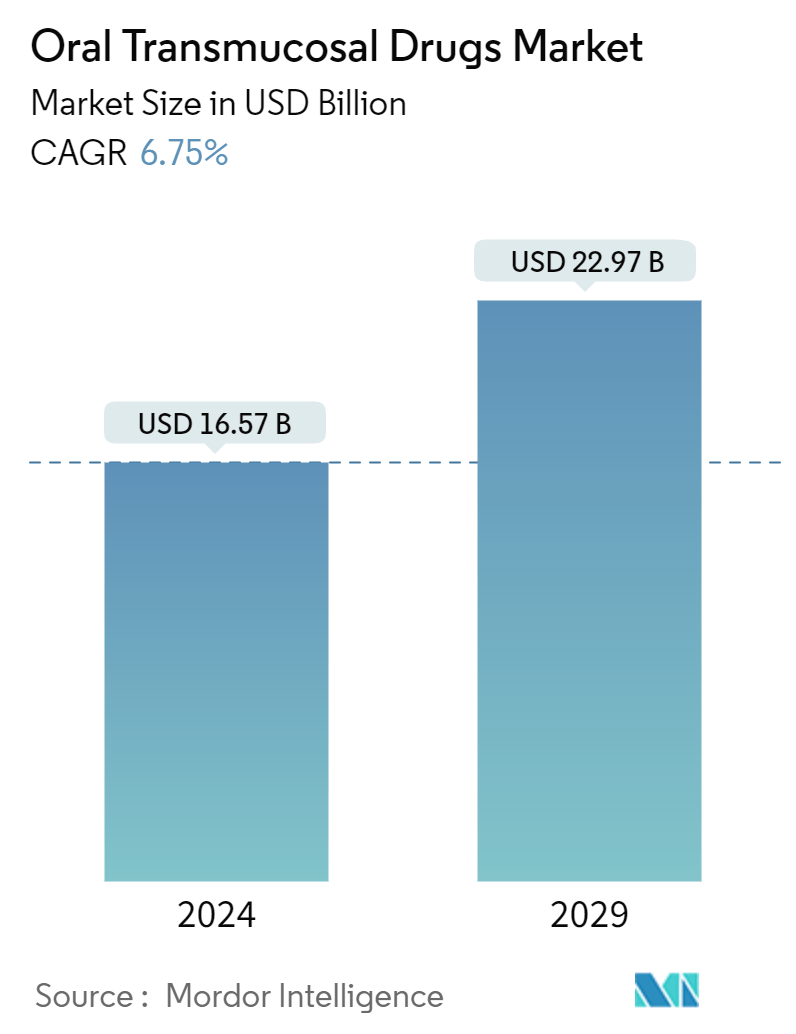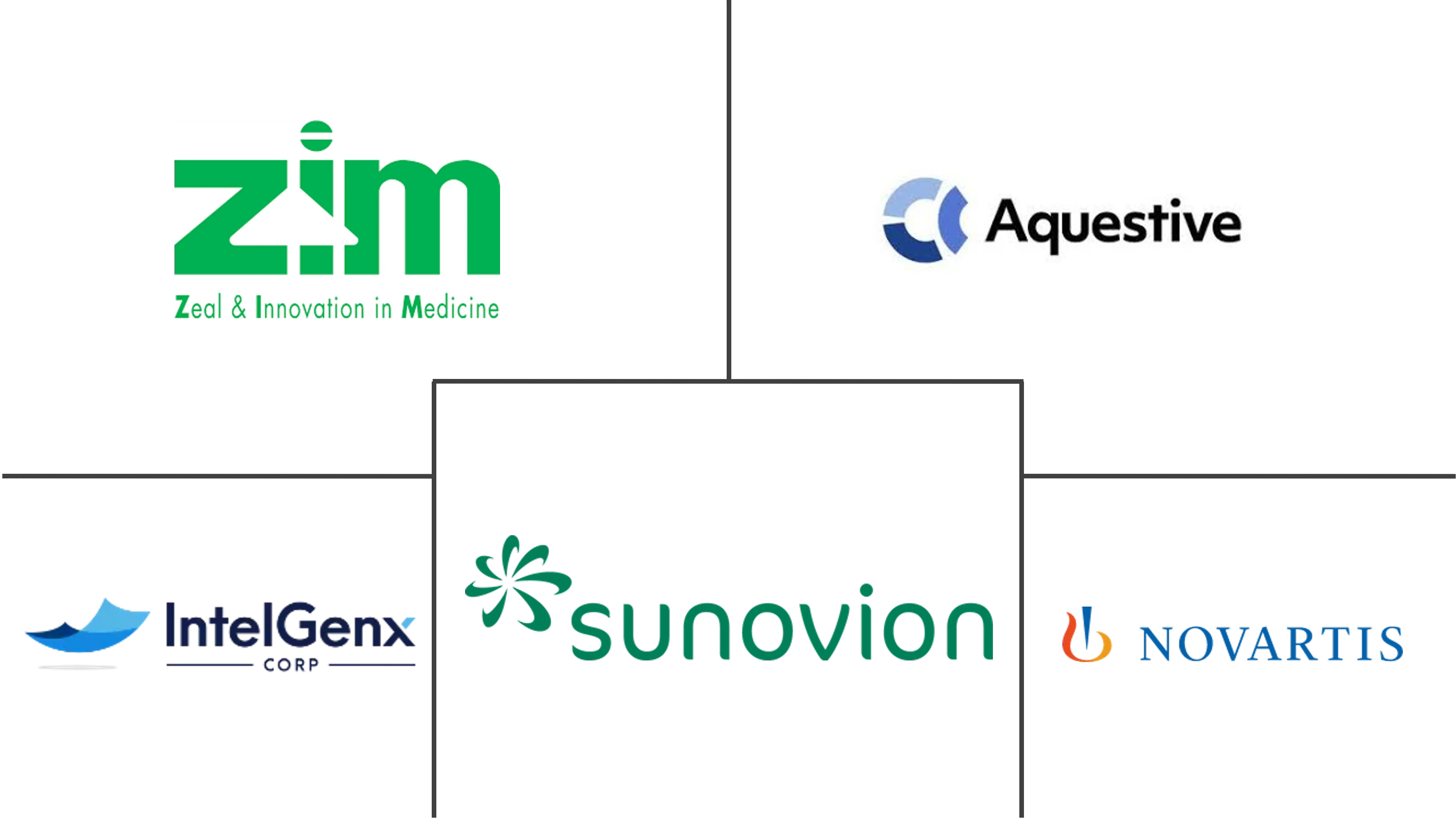Market Size of Oral Transmucosal Drugs Industry

| Study Period | 2019 - 2029 |
| Market Size (2024) | USD 16.57 Billion |
| Market Size (2029) | USD 22.97 Billion |
| CAGR (2024 - 2029) | 6.75 % |
| Fastest Growing Market | Asia-Pacific |
| Largest Market | North America |
| Market Concentration | Medium |
Major Players
*Disclaimer: Major Players sorted in no particular order |
Oral Transmucosal Drugs Market Analysis
The Oral Transmucosal Drugs Market size is estimated at USD 16.57 billion in 2024, and is expected to reach USD 22.97 billion by 2029, growing at a CAGR of 6.75% during the forecast period (2024-2029).
The COVID-19 pandemic had a short-term impact on the oral transmucosal drugs market. Transmucosal drug administration served as an alternative route of drug administration during the COVID-19 pandemic. According to a research study published in November 2020 in NCBI, the COVID-19 pandemic caused a surge in the need for alternative routes of drug administration for end-of-life and palliative care, particularly in community settings. Additionally, this route of drug administration resulted in an excellent method in palliative care to give quick symptom alleviation due to its rapid start of the action and reduced first-pass metabolism. This was crucial amid the COVID-19 pandemic since, in most cases, the patient's condition worsened immediately. Despite their benefits, these routes of administration had limitations, including a mucus barrier, a relatively small surface area for optimal drug absorption, and a small volume of fluid for drug dissolution. As a result, fewer medicines were suited for transmucosal delivery. Thus, due to these limitations, the studied market was adversely affected in the initial phase of the pandemic. However, as per the analysis, oral transmucosal drug manufacturers started capitalizing on the ability of the drugs to offer reduced first-pass metabolism with a speedy onset of action during the later phase of the coronavirus outbreak. These abilities made the drugs suitable for use in sedative treatments to offer prompt relief. Thus, owing to the aforementioned reasons, the market is expected to grow post-pandemic phase.
Moreover, the rise in R&D activities and product launches and the increase in the prevalence of targeted diseases are likely to drive market growth over the forecast period. For instance, in June 2021, Shilpa Medicare Ltd. launched Molshil, a pediatric dose of paracetamol oral thin film, in India. The company received approval after complying with bioequivalence requirements. Additionally, growth in the target population is anticipated to bolster the market's growth. As oral transmucosal fentanyl citrate is an opioid formulation that contains fentanyl in a lozenge and permits drug delivery via the buccal mucosa, this kind of absorption circumvents first-pass metabolism, rendering bioavailability more prominent than the oral route of administration. As a result, growing opioid dependence among the patient population for immediate relief of the pain caused by several disorders is likely to boost the demand for oral transmucosal drugs. For instance, according to the WHO, in 2021, approximately 275 million people used medications (drugs) at least once. Among them, approximately 62 million people used opioids.
Furthermore, the rising burden of Parkinson's disease (PD) and migraine is likely to propel the growth of the oral transmucosal drugs market over the forecast period. For instance, according to Parkinson's Foundation data published in January 2022, nearly one million people in the United States are living with Parkinson's disease. This number is expected to rise to 1.2 million by 2030. Parkinson's is the second-most common neurodegenerative disease after Alzheimer's disease. Approximately 60,000 Americans are diagnosed with PD each year. More than 10 million people worldwide live with PD. Thus, increasing incidences of such disorders are expected to increase the adoption of oral transmucosal drugs for the treatment of such disorders, resulting in better pain management and immediate relief. Thus, the above-mentioned factors are expected to increase the market's growth.
However, disadvantages associated with oral transmucosal drug delivery are expected to hinder the market's growth.
Oral Transmucosal Drugs Industry Segmentation
As per the scope of the report, oral transmucosal drugs are available in different dosage forms such as tablets, thin films, and gels, and are administered orally to dissolve immediately in the mouth. Oral transmucosal drugs can bypass hepatic first-pass metabolism and avoid drug degradation in the gastrointestinal tract. The Oral Transmucosal Drugs Market is Segmented by Product Type (Tablets, Films, Liquid & Spray, and Others), Route of Administration (Sublingual Mucosa, Buccal Mucosa, and Others), Indication (Opioid Dependence, Nausea and Vomiting, Erectile Dysfunction, Neurological Disorders, and Others), Distribution Channel (Hospital Pharmacies, Retail Pharmacies, and Online Pharmacies), and Geography (North America, Europe, Asia-Pacific, Middle East, and Africa, and South America). The market report also covers the estimated market sizes and trends for 17 different countries across major regions globally. The report offers the value (in USD million) for the above segments.
| By Product Type | |
| Tablets | |
| Films | |
| Liquid & Spray | |
| Others |
| By Route of Administration | |
| Sublingual Mucosa | |
| Buccal Mucosa | |
| Others |
| By Indication | |
| Opioid Dependence | |
| Nausea and Vomiting | |
| Erectile Dysfunction | |
| Neurological Disorders | |
| Others |
| By Distribution Channel | |
| Hospital Pharmacies | |
| Retail Pharmacies | |
| Online Pharmacies |
| Geography | ||||||||
| ||||||||
| ||||||||
| ||||||||
| ||||||||
|
Oral Transmucosal Drugs Market Size Summary
The oral transmucosal drugs market is poised for significant growth over the forecast period, driven by the increasing adoption of this drug delivery method due to its rapid onset of action and reduced first-pass metabolism. The COVID-19 pandemic initially posed challenges to the market, as the limitations of transmucosal delivery, such as mucus barriers and small absorption areas, affected its adoption. However, the pandemic also highlighted the benefits of transmucosal administration in palliative care, leading to a resurgence in interest and application. The market is further bolstered by rising research and development activities, product launches, and the growing prevalence of targeted diseases, which are expected to enhance the demand for oral transmucosal drugs. The introduction of new products, such as pediatric doses and opioid formulations, underscores the market's expansion and the increasing reliance on this delivery method for effective pain management and symptom relief.
North America is anticipated to maintain a dominant position in the oral transmucosal drugs market, supported by a high prevalence of conditions such as Parkinson's disease, Alzheimer's, and dental ailments, alongside a growing geriatric population. The region's acceptance of novel drug delivery methods and the increasing number of dental visits further drive market demand. The competitive landscape is characterized by the presence of major players like ZIM Laboratories Limited, Aquestive Therapeutics, Inc., and IntelGenx Corp., who are actively launching new products and seeking regulatory approvals to strengthen their market positions. These developments, coupled with strategic initiatives and partnerships, are expected to propel the market's growth, with oral transmucosal tablets and films playing a crucial role in addressing the needs of patients requiring quick and effective medication delivery.
Oral Transmucosal Drugs Market Size - Table of Contents
-
1. MARKET DYNAMICS
-
1.1 Market Overview
-
1.2 Market Drivers
-
1.2.1 Growing Burden of Target Diseases
-
1.2.2 Rise in R&D Activities and Product Launches
-
-
1.3 Market Restraints
-
1.3.1 Disadvantages Associated With Oral Transmucosal Drug Delivery
-
-
1.4 Porter's Five Force Analysis
-
1.4.1 Threat of New Entrants
-
1.4.2 Bargaining Power of Buyers/Consumers
-
1.4.3 Bargaining Power of Suppliers
-
1.4.4 Threat of Substitute Products
-
1.4.5 Intensity of Competitive Rivalry
-
-
-
2. MARKET SEGMENTATION (Market Size by Value - USD million)
-
2.1 By Product Type
-
2.1.1 Tablets
-
2.1.2 Films
-
2.1.3 Liquid & Spray
-
2.1.4 Others
-
-
2.2 By Route of Administration
-
2.2.1 Sublingual Mucosa
-
2.2.2 Buccal Mucosa
-
2.2.3 Others
-
-
2.3 By Indication
-
2.3.1 Opioid Dependence
-
2.3.2 Nausea and Vomiting
-
2.3.3 Erectile Dysfunction
-
2.3.4 Neurological Disorders
-
2.3.5 Others
-
-
2.4 By Distribution Channel
-
2.4.1 Hospital Pharmacies
-
2.4.2 Retail Pharmacies
-
2.4.3 Online Pharmacies
-
-
2.5 Geography
-
2.5.1 North America
-
2.5.1.1 United States
-
2.5.1.2 Canada
-
2.5.1.3 Mexico
-
-
2.5.2 Europe
-
2.5.2.1 Germany
-
2.5.2.2 United Kingdom
-
2.5.2.3 France
-
2.5.2.4 Italy
-
2.5.2.5 Spain
-
2.5.2.6 Rest of Europe
-
-
2.5.3 Asia-Pacific
-
2.5.3.1 China
-
2.5.3.2 Japan
-
2.5.3.3 India
-
2.5.3.4 Australia
-
2.5.3.5 South Korea
-
2.5.3.6 Rest of Asia-Pacific
-
-
2.5.4 Middle East and Africa
-
2.5.4.1 GCC
-
2.5.4.2 South Africa
-
2.5.4.3 Rest of Middle East and Africa
-
-
2.5.5 South America
-
2.5.5.1 Brazil
-
2.5.5.2 Argentina
-
2.5.5.3 Rest of South America
-
-
-
Oral Transmucosal Drugs Market Size FAQs
How big is the Oral Transmucosal Drugs Market?
The Oral Transmucosal Drugs Market size is expected to reach USD 16.57 billion in 2024 and grow at a CAGR of 6.75% to reach USD 22.97 billion by 2029.
What is the current Oral Transmucosal Drugs Market size?
In 2024, the Oral Transmucosal Drugs Market size is expected to reach USD 16.57 billion.

